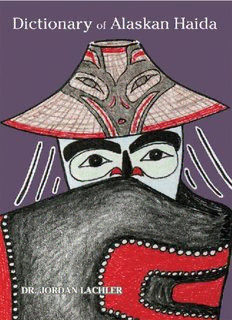
Dictionary of Alaskan Haida - Sealaska Heritage Institute - Alaska PDF
Preview Dictionary of Alaskan Haida - Sealaska Heritage Institute - Alaska
Dictionary of Alaskan Haida Dictionary of Alaskan Haida Dr. Jordan Lachler Sealaska Heritage Institute Juneau, Alaska © 2010 by Sealaska Heritage Institute All rights reserved. No part of this publication may be reproduced or transmitted in any form or by any means, electronic or mechanical, including photocopy, recording, or any information storage or retrieval system, without permission in writing from the publisher. ISBN: 978-0-9825786-5-0 Library of Congress Control Number: 2008939134 Sealaska Heritage Institute One Sealaska Plaza, Suite 301 Juneau, Alaska 99801 907-463-4844 www.sealaskaheritage.org Printing History: First Edition, April 2010 Printing: Create Space, Scotts Valley, CA, U.S.A. Front Cover Design: Kathy Dye Front Cover Artwork: Robert Hoffmann Book design and computational lexicography: Sean M. Burke Copy editing: Suzanne G. Fox, Red Bird Publishing, Inc., Bozeman, MT Table of Contents Acknowledgments…………………………………………….. 7 Introduction…………………………………………………… 8 Dictionary of Haida Haida to English……………………………………….. 23 English to Haida……………………………………….. 481 Dictionary of Alaskan Haida - Acknowledgments - 7 Acknowledgments It is important to recognize the elders who contributed to the creation of this dictionary—Erma Lawrence, originally from Kasaan and now living in Ketchikan; Claude Morrison of Hydaburg; the late Woodrow Morrison of Hydaburg; and the late Anna Peele of Hydaburg, all devoted hundreds of hours to this project. Their remarkable knowledge of the Haida language and dedication to seeing the language live on inspired us all. Without all their steadfast efforts, this dictionary would not have been possible. Daláng 'wáadluwaan an Hl kíl 'láa áwyaagang! Thanks are also due to our intrepid group of intermediate Haida language students—Skíl Jáadei (Linda Schrack), 'Wáahlaal Gíidaak (Starla Agoney), Patrick Garza, Eliasica Timmerman, and Cara Wallace—for the hard work they have invested in learning the language. I look forward to the day when we all will know every word in this dictionary. Thanks to Sean M. Burke for his many hours of technical assistance in creating the database and writing the custom rendering engines for the dictionary. Thanks are also due to the Administration for Native Americans for funding this project, and to the Sealaska Corporation for their ongoing support of all the efforts of Sealaska Heritage Institute. Jordan Lachler, Ph.D. Ketchikan, Alaska April 10, 2010 Sealaska Heritage Institute 8 - Introduction - Dictionary of Alaskan Haida Introduction This dictionary has been written primarily for beginning and intermediate students of Alaskan Haida. In this first edition, we have included approximately 5,500 main entries, covering many of the most frequently used words in the language. This represents, however, only a fraction of all Haida words. In future editions, we aim to include more words for intermediate and advanced language students. Xaad Kíl The Haida language, or Ýaad Kíl, is the traditional language of the Haida people. In earlier times, Ýaad Kíl was spoken in villages throughout Ýaadláa Gwáayaay, the islands we now call Haida Gwaii. Over time, some people from the northern areas of Ýaadláa Gwáayaay migrated across the fifty-mile-wide Dixon Entrance, and settled in villages on the southern shores of Prince of Wales Island. These people were known as Ñ'íis Ýaat'áay, and their descendants are the Haida people of Alaska. Today, Ýaad Kíl is one of the world’s most endangered languages—only about 50 speakers remain in all of the Haida communities. None of these speakers is younger than sixty, and most of the very best speakers are in their eighties and nineties. As with most languages spoken over such a wide territory, the way that Ýaad Kíl is spoken varies from community to community. We can divide the language into two main dialects: Southern Haida and Northern Haida. Southern Haida is currently spoken in Skidegate, where the language is known as Ýaayda Kil. Northern Haida is spoken in Old Massett, as well as in Hydaburg, Kasaan, and other communities in Alaska. Even within each dialect area, pronunciation, vocabulary, and grammar sometimes vary from community to community. In fact, it’s possible to find differences between individual speakers living in the same community, but none of the differences have much effect on speakers’ ability to understand one another. All speakers of Southern Haida can understand other speakers of Southern Haida, and all speakers of Northern Haida can understand other speakers of Northern Haida. When speakers of Northern Haida and Southern Haida talk with one another, however, the situation is more complex. Some elders report that they understand the other dialect just fine. Others say that they can follow the general flow of a conversation in the other dialect, but they don’t necessarily catch every word. Still other elders tell us that they find it very difficult to understand much of the other dialect. Sealaska Heritage Institute
Description: